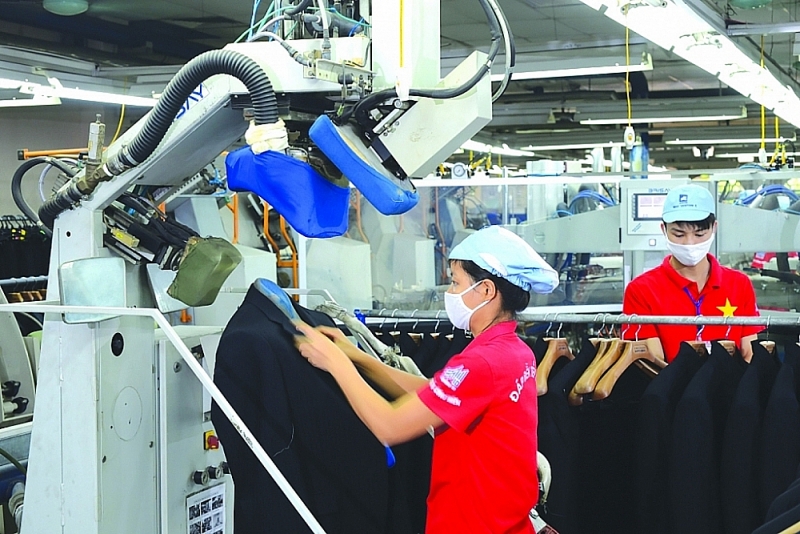 |
| Since the third and fourth quarters of 2023, the total demand for textiles and garments may recover in proportion to the decrease in inflation. Photo: Ng.Thanh |
Being out of orders, it reaches the destination of US$43 billion
According to the Vietnam Textile and Apparel Association (Vitas), in ten months of 2022, the textile and garment industry exported nearly US$38 billion, an increase of more than 17% compared to the same period in 2021. The textile and garment industry has exported to sixty-six countries and territories with about forty-seven to fifty items, of which a large proportion of exports are clothing and apparel.
Mr. Vu Duc Giang, President of Vitas said: in ten months of 2022, the largest export market of Vietnam’s textiles and garments is the US, accounting for US$13.9 billion; ranked second is the market of countries in the Comprehensive and Progressive Agreement for Trans-Pacific Partnership (CPTPP) with nearly US$4.8 billion; The EU market ranked third with nearly US$3.4 billion and Korea ranked fourth with US$2.5 billion.
Although there were many advantages in the first half of the year, textile and garment exports faced many difficulties in the second half of the year. Currently, export enterprises are under great pressure to reduce orders.
Mr. Nguyen Xuan Duong, Chairman of the Board of Directors of Hung Yen Garment Corporation (Hugaco) said: in the past ten months, the company’s total export turnover increased by about 8% over the same period in 2021. However, there is a lack of orders because partners move to markets with cheap labour and low tax rates such as Bangladesh, Myanmar, and Africa.
“Currently, Hugoco has orders until the end of November 2022 and half of December 2022. The remaining shortage can be compensated by receiving small orders from Korea and some other markets such as Japan and China. Therefore, not only having difficulty in a quantity of orders, the unit price of textiles and garments reduced by more than 20%, even with orders reduced by 40-50%, “said Mr. Duong.
Regarding textile and garment exports this year, Vitas forecasts that the whole industry will reach the destination of about US$43 billion. The President of Vitas explained: “Vietnam has 15 FTAs already in effect, which is the foundation for creating market diversification solutions. This is a very special element. Along with that, inflation and the decrease in purchasing power of major countries have created pressure for Vietnamese enterprises to find solutions to diversify export markets and promote finding new markets. Many businesses have strongly transformed, and promoted digital governance, sought self-sufficiency in domestic supply chains, diversified products, etc. All of these factors help Vietnam’s textile and garment export achieve results significantly, maintaining exports to sixty-six countries and territories”.
Textile demand recovers in third quarter 2023
The pressure to reduce orders in the textile and garment industry is forecasted to last until the first quarter of 2023, with an average decrease of 20-27%. Mr. Vu Duc Giang assessed: “The global purchasing power decreased, the textile and garment industry’s decrease was still less than the leather, footwear, and wood industries, etc. The processing enterprises will be more affected. Exporting enterprises that are proactive in raw materials will be less affected.”
According to Mr. Le Tien Truong, Chairman of the Board of Directors of Vietnam National Textile and Garment Group, it will take from the third and fourth quarters of 2023 for the total demand for textiles and garments to recover in proportion to the decrease in inflation. Giving specific export targets, Mr. Vu Duc Giang stated that in 2023, the textile and garment industry set an export target of US$45-47 billion. This target is based on the basis that in 2023, the EU-Vietnam Free Trade Agreement (EVFTA) will bring the tax rate to 0%. This is the driving force promoting investment shift from outside into Vietnam.
“Over the past time, the whole industry has faced difficulties, but the investment movement of countries in the region into Vietnam has been relatively breakthrough. Additionally, Vietnamese enterprises have been actively promoting domestic raw materials with an increasing proportion. In addition, Vietnam’s sustainable development, digital governance and circular economy programs attract brands to choose Vietnam. Therefore, it is expected that if the global purchasing power has positive changes, the textile and garment export target in 2023 can be adjusted shortly,” said Mr. Vu Duc Giang.
In addition to the orders referring to the outstanding difficulties that textile and garment export enterprises have been facing, a representative of Vitas said: typically, the problem of retaining employees. Labour is the number one asset of enterprises, above all technological equipment and factories, so even in the context of declining orders, businesses must try to retain workers. As a result, many units have had to transfer from garment production to making bags for supermarkets to have jobs for workers while waiting for the textile industry to recover next year.
In addition, many textile and garment enterprises face capital difficulties. The textile and garment industry is recommending to the government, ministries, and branches to consider tax reduction or tax delay for businesses. “Regarding bank interest rates, it is suggested that for some industries with large export impacts, job creation and large labour such as textiles and garments, banks should consider keeping a reasonable interest rate to encourage businesses to maintain production”, Mr. Vu Duc Giang said.
